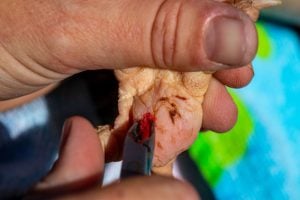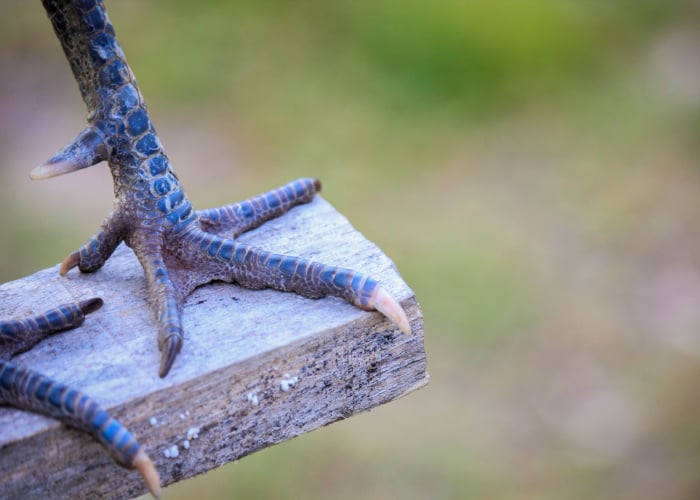Chickens have long been a symbol of farm life and a source of food for centuries.
While picturesque appearance is widely recognized, have you ever wondered about the intricacies of their feet, like how many toes do chickens have?
In this article, we will delve into the ordinary yet fascinating world of chicken toes, exploring their anatomy, function, and the number of toes chickens possess.

The Anatomy of Chicken Feet
Before we get into the specifics of chicken toes, let’s take a closer look at theoverall structure of chicken feet.
Chicken feet consist of several parts that contribute to their unique functionality.
Each foot has three main segments: the tarsus, metatarsus, and toes.
The tarsus, also known as the shank, is the lower part of the leg between the hock joint and the foot.
It is a long, slender bone covered by scaly skin.
The metatarsus, or the foot proper, is the region between the tarsus and the toes.
It consists of several small bones that provide support and flexibility to the foot.
The toes are the most intriguing part of a chicken’s foot.
Unlike many other animals, chickens have a distinctive toe arrangement.
Most chickens have four toes, three facing forward and one pointing backward.
This configuration allows them to maintain balance and stability on various types of terrain.
It also allows them to dig, roost, and pick through their forage.
How Many Toes Do Chickens Usually Have?
Now let’s focus on the central question: How many toes do chickens have?
As mentioned earlier, most chickens have four toes.
The three forward-facing toes are known as the primary toes, while the backward-facing toe is called the hind toe.
This arrangement is commonly seen in most chicken breeds.
The primary toes are slender, straight, and equipped with sharp claws.
They serve multiple purposes, such as providing traction while walking, scratching the ground for food, and perching on branches or roosts.
Though smaller and less prominent, the hind toe plays a crucial role in maintaining balance and grip on uneven surfaces.
It’s what wraps around the perch or libs whenchickens roost at night.
Variations in Chicken Toe Counts
While four toes are the norm, not all chickens have the same number of toes.
Occasionally, genetic variations or developmental abnormalities can result in chickens having fewer or more than the standard toe count.
Some chickens may have a condition calledpolydactyly, where they possess extra toes.
These extra digits are usually non-functional and do not provide any significant advantage to the bird.
Polydactyly is relatively rare and often occurs as a result of genetic mutations.
There arefive specific breeds of chickens with five toes.
另一方面,鸡少于4 toes are also occasionally observed.
Some may have a condition known as oligodactyly, where they possess only two or three functional toes.
Despite the reduced toe count, these chickens can lead healthy lives and adapt well to their environment.
Oligodactly differs from ectrodactyly, but a chicken can have both conditions simultaneously.
Ectrodactyly is also known as split or cleft hand; it’s been found in humans, chickens, cats, dogs, frogs, toads, mice, salamanders, and manatees.
Usually, this is hereditary.
It’s important to remember that toe count variations usually do not affect chickens’ overall health or well-being.
They are simply unique attributes that add to the diversity of different breeds.
The Functional Purposes of Chicken Toes
The arrangement of chicken toes serves several practical purposes, aiding in their daily activities and survival.
The sharp claws at the end of each toe allow chickens to dig and scratch the ground effectively.
This behavior is instinctual and helps them uncover insects, worms, seeds, and other food sources.
Chicken toes also play a crucial role in perching.
Whether on tree branches, fence posts, or roosts, the arrangement of their toes allows them to grip and maintain balance, preventing falls and injuries.
This perching behavior is a natural instinct and serves as a way to rest, observe their surroundings, and seek safety from predators.
What To Do If a Chicken Loses a Toe
Chickens can lose toes due to frostbite, predators, injuries, nutritional deficiencies, or even some types of illnesses.
The best thing you can do is determine what caused the loss and then work from there to help your chicken.
Most chickens can live a healthy and happy life without a few toes but may need some accommodations from you to do well.
Chickens with missing toes may need wider roosts, lower roosts, or more feed provided to them since scratching foraging will be more difficult.
Bumblefoot
Chickens use their feet, quite literally, twenty-four hours a day, even using them to hold them upright while they sleep at night.
This makes them more susceptible to pododermatitis, otherwise known as bumblefoot.
This affliction is characterized by inflammation and infection of the foot pad, usually caused by a bacterial infection.
Bumblefootcan be painful and, if left untreated, can lead to more serious complications, like losing toes or toenails.
The primary cause of bumblefoot is a cut or injury to the foot pad, which allows bacteria to enter and cause infection.
Chickens can develop bumblefoot from walking on rough or sharp surfaces, such as gravel or wire mesh, or from trauma caused by jumping orperching on hard surfaces.
Poor coop conditions, including dirty or wet bedding, can also contribute to the development of bumblefoot.
The symptoms of bumblefoot in chickens include swelling, redness, and heat in the affected foot.
A hard, dark scab or callus may develop on the foot pad, which can cause lameness and difficulty in walking.
In severe cases, abscesses may form, leading to pus-filled lesions that require drainage and treatment.
Treatment for bumblefoot typically involves cleaning the affected foot and removing the scab or callus.
This should be done under sterile conditions, and it is essential to be gentle to avoid causing further injury or pain to the chicken.
Antibiotics may be prescribed by a veterinarian to treat the underlying infection.
Additionally, providing clean, dry bedding and ensuring proper coop conditions can help prevent the recurrence of bumblefoot.
Prevention is key when it comes to bumblefoot in chickens.
Regularly inspecting the flock’s feet can help identify any cuts or injuries early on.
Providing a clean and comfortable environment with appropriate bedding, avoiding rough or sharp surfaces, and promoting good hygiene practices can greatly reduce the risk of bumblefoot.
Trimming chickens’ toenails regularly can also help prevent injuries and reduce the chances of bumblefoot developing.
You likely won’t need to trim chicken toenails if they have access to gravel or rock, but this may become necessary for chickens kept in coops with soft runs.
Injuries
Chickens can get their toes caught in netting, chicken wire, in between cracks of boards, or even hung up in trees.
They also risk pulling off or breaking a toe during their fight to free themselves.
This is more likely if a predator, such as a dog or a fox, bites or pulls on the foot during an attack.
Frostbite
A chicken who suffers frostbite may later lose toes or even their entire foot.
Here are a few ways toprevent frostbite in your flockandkeep chickens warmover the winter.
Nutritional Deficiencies
It’s rare for a chicken to lose toes or feet from deficiencies, but it’s still an option.
The most probable cause would be a calcium deficiency.
Calcium is incredibly importantfor chicken health.
It enables hens to produce eggshells, and it lets all flock members with the following:
- Balancing internal pH levels to support optimal bodily functions
- Regulating heart rate
- Absorbing and utilizing phosphorus
- Controlling muscle spasms, especially in the muscles used to lay eggs
- Hormone production and reproductive system regulation
- Blood clotting
- Maintaining a healthy nervous system that is responsible for transmitting signals and coordinating bodily functions
- Activating digestive enzymes to aid in the breakdown and absorption of nutrients from food supports efficient digestion.
- Ensuring proper bone development and growth. The chicken’s body maintains strong and healthy bones, which is crucial for mobility, support, and overall well-being. The toes especially need calcium because they do a lot of work every day and must be able to maintain their structural integrity.
FAQs related to Chicken Toes
Can you tell the sex of a chicken by counting its toes?
No, you cannot tell the sex of a chicken by counting its toes.
Both male and female chickens have the same number of toes.
Mostly, chickens have four toes on each foot; three toes pointing forward and one toe pointing backward.
不过有几个品种,有5个脚趾。
What happens if a chicken loses a toe?
If a chicken loses a toe, they are usually able to adapt and continue to function normally.
However, losing a toe can affect a chicken’s balance and ability to perch, making them more susceptible to foot injuries.
How can you prevent chickens from losing toes?
Providing a clean and safe living environment is important to prevent chickens from losing toes.
This includes providing a dry and comfortable place to roost, keeping their living area free of sharp objects or obstacles, and keeping their nails trimmed to prevent them from catching on objects.
Can chickens walk normally with missing toes?
鸡能正常行走与失踪es, although it may affect their balance and ability to perch.
If a chicken loses multiple toes, it may be more difficult for them to walk or perch.
Can chickens with missing toes still lay eggs?
Yes, chickens with missing toes are still able to lay eggs.
The number of toes a chicken has does not affect their ability to lay eggs.

How Many Toes Do Chickens Have: Final Thoughts
Chicken toes are a fascinating aspect of these familiar farm birds.
With their unique arrangement and functional adaptations, chickens’ toes are vital for maintaining balance, facilitating movement, and aiding in daily activities such as scratching and perching.
While most chickens possess four toes, genetic variations can occasionally result in individuals having three or five toes instead.
